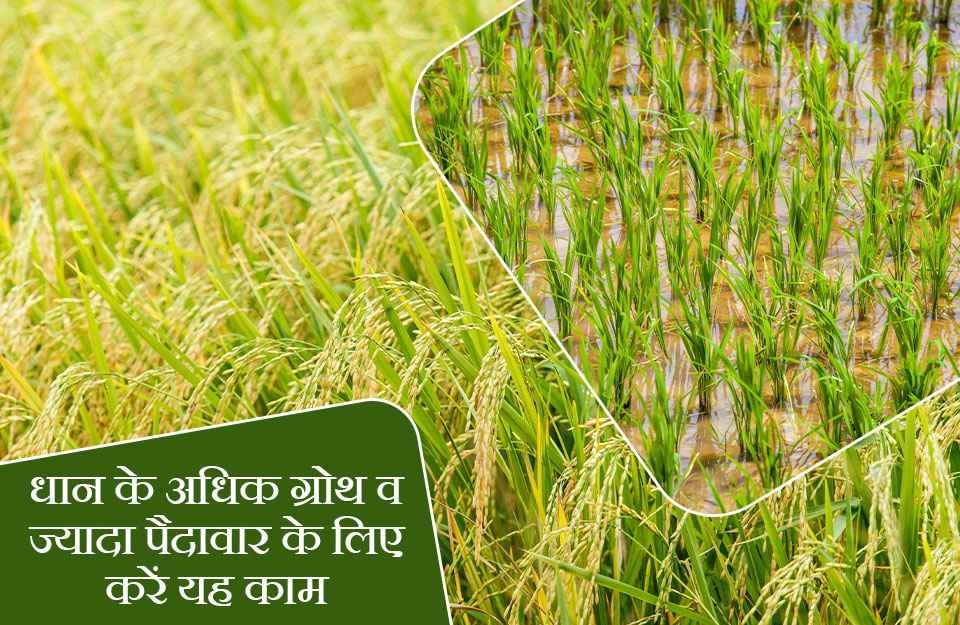
Rice is one of India's most important staple crops, cultivated on a global scale. To ensure optimal production of rice, it requires favorable environmental conditions and proper nutrition. During its growth stages, rice undergoes various phases, with the emergence of tillers holding special significance. Managing appropriate fertilization during rice tillering stages is crucial for enhancing crop productivity.
Rice tillering is the process through which rice plants develop secondary shoots or tillers from the main stem's basal nodes. These tillers emerge during the vegetative stage of the plant and play a vital role in determining the final count of productive panicles, which directly enhances grain yield. Tillering typically occurs during the initial stages of rice development, starting two to five weeks after transplanting or direct seeding, depending on environmental conditions.
During the period of 25-50 days after rice transplantation, tillers start to emerge in the rice crop. This is the time when rice plants require the most nutrition. Apply a mixture of 20 kilograms of nitrogen and 10 kilograms of zinc per acre by broadcasting it over the crop. Azolla fertilizer can also be introduced into the crop.
Utilize Organic Fertilizers: Increasing the use of organic fertilizers is advisable for obtaining a good yield from rice crops. According to experts, using rice enzyme gold can be highly beneficial. Rice enzyme gold is derived from marine grass, which aids in the growth of rice plants. It functions similarly to Azolla, reducing the likelihood of pest and disease infestation. To apply it, mix rice enzyme gold in one liter of water and spray 500 liters of this solution per hectare of land.
Timing of Rice Tillering: Tillers start to emerge within 20 to 40 days after planting, and their number gradually increases. As the rice plant grows, it actively develops tillers, leading to significant tiller production. In the final stage of tiller formation, the rice plant ceases to produce new tillers and begins to focus on the growth of flowering clusters.
Use of Thinning in Rice Fields: Thinning should be done around 20 days after rice transplantation. This process provides a slight shock to the roots of the rice plants, encouraging even the smaller or lighter crops to germinate and grow. It's essential to have water in the field during thinning. Thinning helps dislodge any pests or insects that may harm the crops, preventing potential damage. Thinning should be done in both clockwise and counterclockwise directions.
Drainage from Fields: Rice is a water-intensive crop. Approximately 20-25 days after transplantation, water should be drained from the fields. However, the soil should not be completely dried out; it should remain moist. Draining allows direct sunlight to reach the roots of the rice plants and ensures sufficient oxygen supply to the crops. This period is also suitable for weeding and loosening the soil.
Proper Fertilizer Management:
During the tillering stage, proper fertilizer management is crucial for rice cultivation. Correct fertilizer application not only affects the number of tillers but also influences overall crop health and productivity.
Protection from Bacterial Leaf Blight in Rice Crops: Bacterial leaf blight is a prevalent disease that typically affects rice crops, capable of causing significant damage to agricultural yields.
Symptoms: Bacterial leaf blight can be observed at various stages of rice growth. Initially, infected leaves appear yellowish or straw-colored and wither. From the emergence of tillers to the formation of panicles, during the rice plant's developmental stages, water-soaked streaks of light green to brownish-green color can be seen on the leaves. These streaks eventually merge to form large, yellow lesions with uneven margins. As the infection progresses, milky bacterial ooze may be visible from the leaves.
Prevention from Bacterial Leaf Blight: Select rice varieties that are resistant to bacterial blight, handle plants with care during transplantation to prevent damage, ensure proper field and nursery drainage, supplement the final nitrogen application with an additional dose of potassium under favorable weather conditions, clean up weeds to reduce bacterial spread, and apply chemical controls: spray Copper Hydroxide 53.8% DF, Streptomycin Sulfate 90.0% SP, and Tetracycline Hydrochloride 10.0% SP.
Conclusion: The formation of tillers in rice is a crucial stage that determines the final grain yield. Understanding the factors influencing tiller formation, the stages of tiller emergence, and proper fertilizer management is essential for successful rice cultivation. Proper fertilizer management is critical for promoting healthy tiller development, enhancing stress resistance, and maximizing productivity. By providing essential nutrients to rice plants and maintaining favorable environmental conditions, farmers can maximize tiller production, leading to abundant rice crops and contributing to food security for millions worldwide.